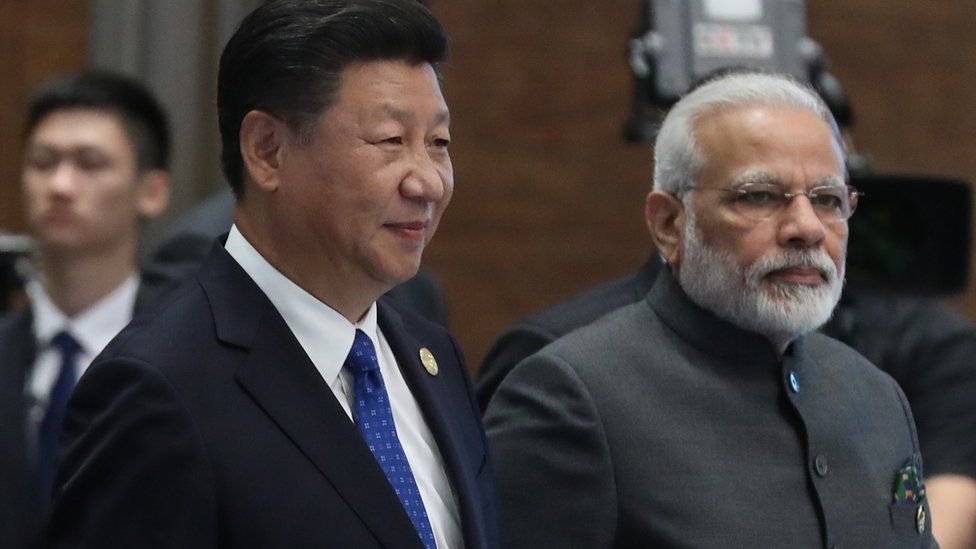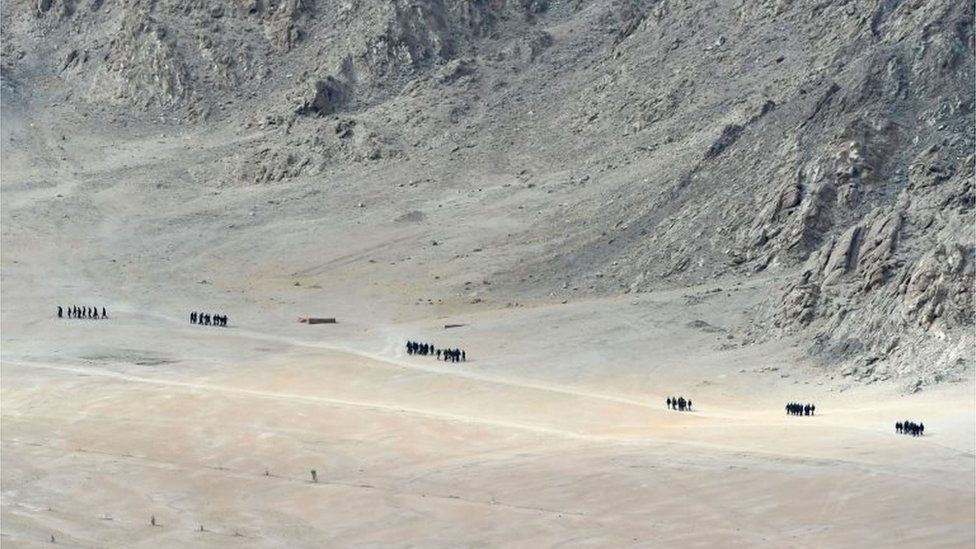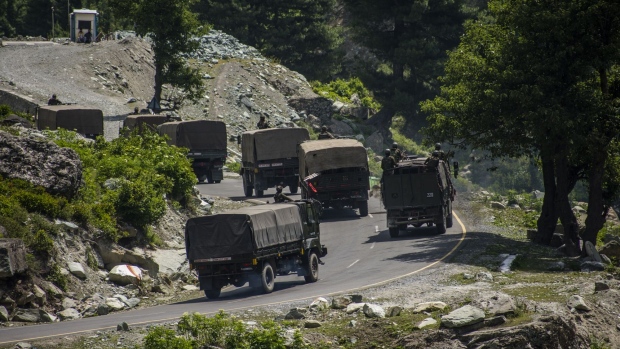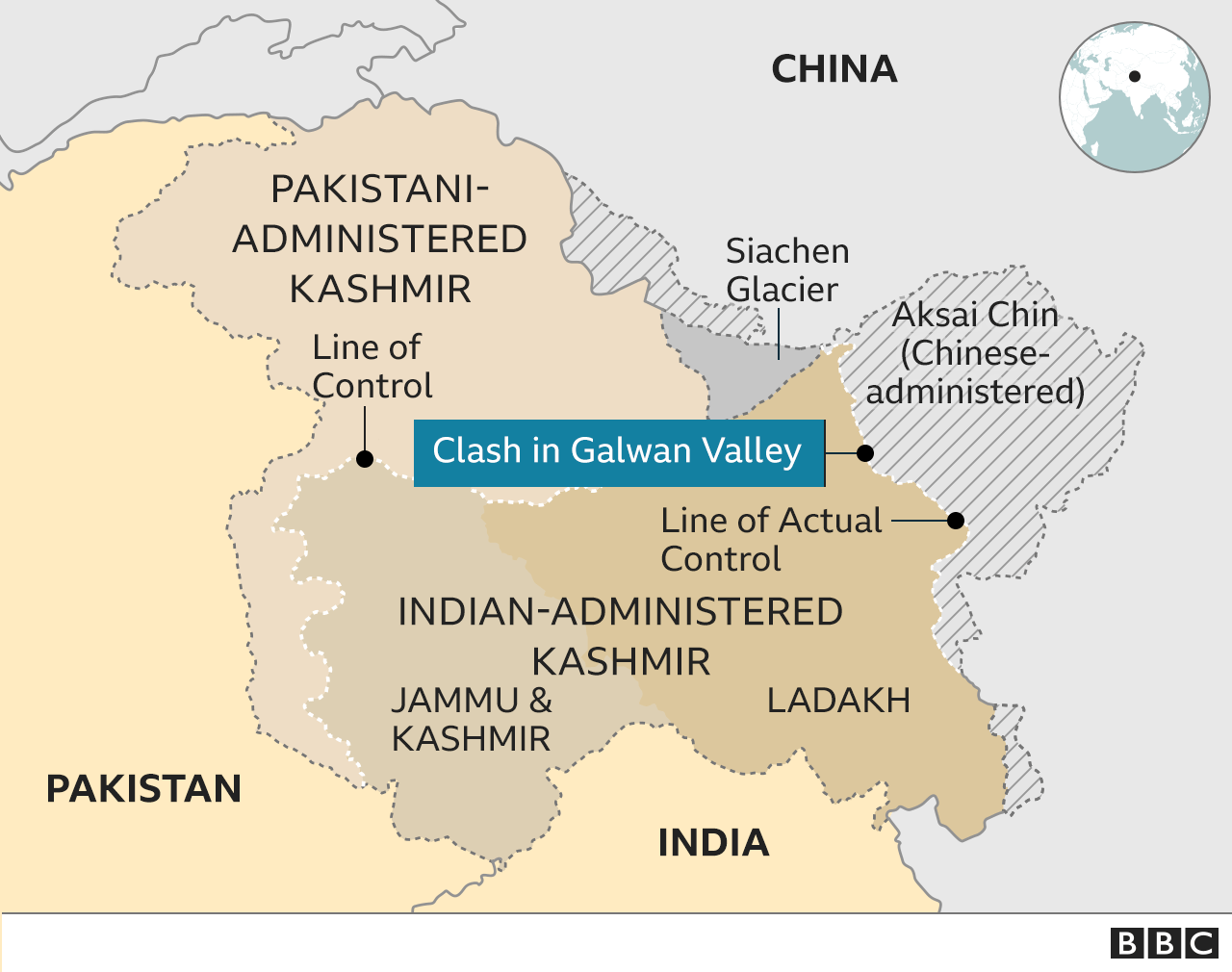Goliath vs Goliath
"The current situation on the border between China and India is generally stable, and the two sides are negotiating to resolve relevant border issues.""In this context, the words, deeds and military deployments of relevant military and political leaders should help ease the situation and increase mutual trust between the two sides, not the other way around."Chinese Foreign Ministry spokesman Wang Wenbin
 |
| Xi Jinping, left, and Narendra Modi had previously played up a personal bond Getty Images |
"Having so many soldiers on either side is risky when border management protocols have broken down.""Both sides are likely to patrol the disputed border aggressively.""A small local incident could spiral out of control with unintended consequences."Lieutenant-General D.S. Hooda, former Northern Army commander, India
 |
| Indian troops near the border with China Getty Images |
Chinese
spokesmen for the government speak reasonably and always portray the
Chinese Communist Party ruling Politburo as bearing no ill intentions
whatever toward any other country. Peace always uppermost in Beijing's
collective mind. Conflict or creating situations that might lead to
misunderstandings not their way at all. The sterling quality of
'harmony', within China itself and between the government and its
international counterparts represents the goal sought by Beijing.
A
Beijing that cannot seem to fathom that its insatiable appetite for
acquiring the world's natural resources; for excelling in technological
advances, achieved in part by pirating advances and formulae and
technologies from other international sources which China can then
self-produce with a specific Chinese flair and application in proud
ownership; a China that cannot abide the thought that its neighbours
have an equal right to disputed territories; or that international
waters and airspace are to be shared, is one that raises the hackles of
those it constantly undercuts and outmanoeuvres.
The
two nations, restless neighbours, each with immense billion-plus
populations, powerhouses of potential in science, technology and
academic excellence but with opposing political systems, have long been
uneasy with each other's proximity and penchant toward rivalry.
Invariably, however, it is China that becomes the aggressor in its
hunger for control and possession. Last summer was a testy one for
China-India relations. Border skirmishes in the Himalaya over a
tentative border saw India lose control over some 300 square kilometres
along the disputed mountain terrain.
China's
intentions are oblique until they become evidently transparent. The
People's Liberation Army brought in forces from Tibet to the Xinjiang
Military Command, responsible for patrolling the disputed areas along
the Himalayas. Fresh runway buildings, bombproof bunkers meant to house
fighter jets and new airfields have appeared along the Tibetan disputed
border. Long-range artillery, tanks, rocket regiments and twin-engine
fighters have been added in the last few months.
Irrelevant
to relations between the two countries. Whatever Beijing decides must
be done within Chinese territory is of no business to its neighbours.
All is well, the border undisturbed, there is no reason for India to
leap to conclusions. Neighbours must trust one another's good
intentions. The amassing of troops and arms? Negligible training
exercises.
 |
| Indian soldiers on patrol near Leh, in the disputed frontier region of Ladakh AFP |
India,
given its experiences with China both in the past and at present,
thinks otherwise. It has brought in an additional 50,000 troops to the
border; an obvious offensive military move against a neighbour more
accustomed to acting out treacherous moves than relying on diplomatic
niceties. India has moved its own troops and fighter jet squadrons to
three areas along its border with China, to the point where there are
now 200,000 Indian troops stationed on the border.
In
the past, the military presence was directed toward blocking moves
China might make; the present redeployment is set to give Indian
commanders flexibility in options where they may attack and seize
territory in China should it be seen to be necessary; a strategic ploy
known as "offensive defence". Where helicopters are assigned to airlift
soldiers from valley to valley, as well as artillery pieces like the
M777 howitzer. These are not preparations taken lightly.
The
recent diplomatic skirmishes representing military-diplomatic
discussions with China have seen no progress reaching a return to the
decades-old status quo so rudely interrupted by China's acquisitory
challenges. The largest increase in troop levels have taken place at the
northern region of Ladakh, where the two countries met in brief
conflict on several occasions last year. Among India's transferred
soldiers are some once involved in anti-terrorism operatons against
Pakistan; newly deployed on the border.
 |
| An Indian army convoy drives towards Leh, on a highway bordering China, on June 19, 2020 in Gagangir, India. As many as 20 Indian soldiers were killed in a "violent face-off" with Chinese troops on Tuesday in the Galwan Valley along the Himalayas. Chinese and Indian troops attacked each other with batons and rocks. Photographer: Yawar Nazir/Getty Images AsiaPac |
Henceforth,
India will have greater troop numbers acclimatized to fight in the
high-altitude Himalaya, reducing the number of troops stationed on
India's western border with Pakistan. A fragile situation, to be sure.
In the more populated area along the southern Tibetan plateau, soldiers
with machine guns joined lightly armed paramilitary officers. Most of
India's border forces were located in the far eastern state of Arunachal
Pradesh, where the1962 India-China war took place, French-produced
Rafale fighters armed with long-range missiles are deployed in support
of the boots on the ground.

Labels: Border Skirmishes, China, Conflict, Disputed Territory, Himalaya, India

<< Home